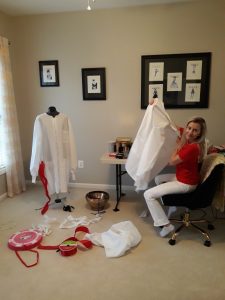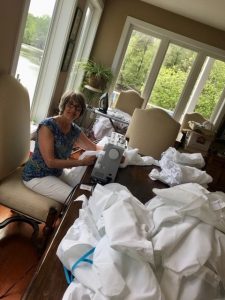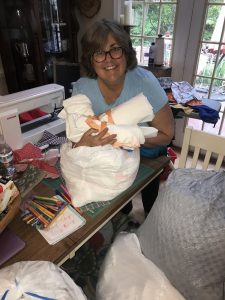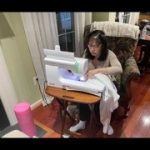Holding a red marker, Teri Boss writes ‘thank you’ on the inside label of each newly sewn gown. She sketches a tiny red heart beside every ‘thank you’ she writes. These gowns do not have an ordinary purpose. They adorn the backs of nurses at Anne Arundel Medical Center (AAMC) who are working every minute to save the lives of COVID-19 patients.
Boss is one of nearly 40 community volunteers who have sewn almost 900 isolation gowns for the nurses of AAMC. In April, during our patient surge, the sewers produced 50-80 gowns a day.
“I wanted to give back and take care of my country during this difficult time,” said Boss, a first-generation Polish American, who came to the U.S. in the early 2000s. “The love I’ve received from people in this country inspired me to help.”

Teri Boss is one of nearly 40 community volunteers who have sewn almost 900 isolation gowns for the nurses of AAMC.
Despite great efforts to conserve gowns during the pandemic, the supply was running low and more were needed for nurses caring for COVID-19 patients.
“None of us were sleeping. We were worried about running out of isolation gowns,” said Joan Twigg, RN, who coordinated the gown conversions. “We have to protect our health care workers during this pandemic and back then we were seeing a lot more COVID-19 patients than we are now.”
Sewing Angels
Twigg said AAMC obtained 800-1,000 lab jackets to help with the shortage. They were not an easy replacement to isolation gowns because they opened in the front. Isolation gowns open in the back to prevent contamination. Twigg took some of the lab jackets home to see if she could make them work. Despite creating a prototype isolation gown, which sealed up the front and opened in the back, she still had a problem.
“I brought them into the hospital and said ‘If we could just get a room full of sewers for two days we can do this,’” Twigg said.
This was not an easy fix due to social distancing and visitor restrictions enacted by the hospital to protect patients and staff.
Twigg contacted a friend who is a family and consumer sciences (FACS) education teacher to see if she could help or knew anyone who could. The friend connected her to FACS teacher, Lenore Martin, who reached out to her sewing network. Martin, who has sewn for years, reached out to fellow sewers and created a video to show them how to put the gowns together. With that, the volunteer COVID-19 sewing gown operation was born.

Volunteer Lenore Martin sews gowns for AAMC nurses.
“I think all of us feel great about being able to help,” Martin said. “It’s not a lot that people who aren’t qualified in the medical field can really do right now. I’m just really thankful that our sewing abilities are able to be beneficial to the hospital and to the nurses.”
The gowns are made out of tent-like material and are washable for reuse. The reuse factor solved the gown shortage problem.

Volunteer Julie Bays
Julie Bays is a FACS teacher and a lifelong sewer. She learned from her grandmother at the age of 10. She calls sewing her “happy place” and was glad to join the team of sewers. Helping was personal for her.
“I have a daughter who works in the emergency room,” Bays said. “I admire how she gets up and goes to work every day with such a willing spirit. It was really nice that I could do a little bit to help the people on the front lines.”
The volunteers’ work has not gone unnoticed. They have received notes of thanks from nurses and photos with them wearing their gowns. Some AAMC nurses refer to the network of sewers as angels. They have sent pictures holding up signs that say, “Thank you, sewing angels.”
Making a Difference
Bays and other volunteers have also sewn masks and scrub caps for AAMC during the pandemic.

Volunteer Monette Callahan
Like Bays, Monette Callahan also has a personal connection to health care. Her son is an ICU nurse who is currently caring for COVID-19 patients in Baltimore. Regularly he tells her of the challenges that front line workers are facing.
“My son says, ‘This is for real mom. This is scary. It’s not like what you see on social media,” Callahan said.
Ultimately, Callahan wants to do her part to support her son as well as others working on the front lines of the COVID-19 pandemic.
“I enjoy sewing the gowns because I know I’m helping and making a difference in my own way,” she said. “I have the skills, I have the machine and I have the time. Why not go ahead and help?”
Learn ways you can help our community.




